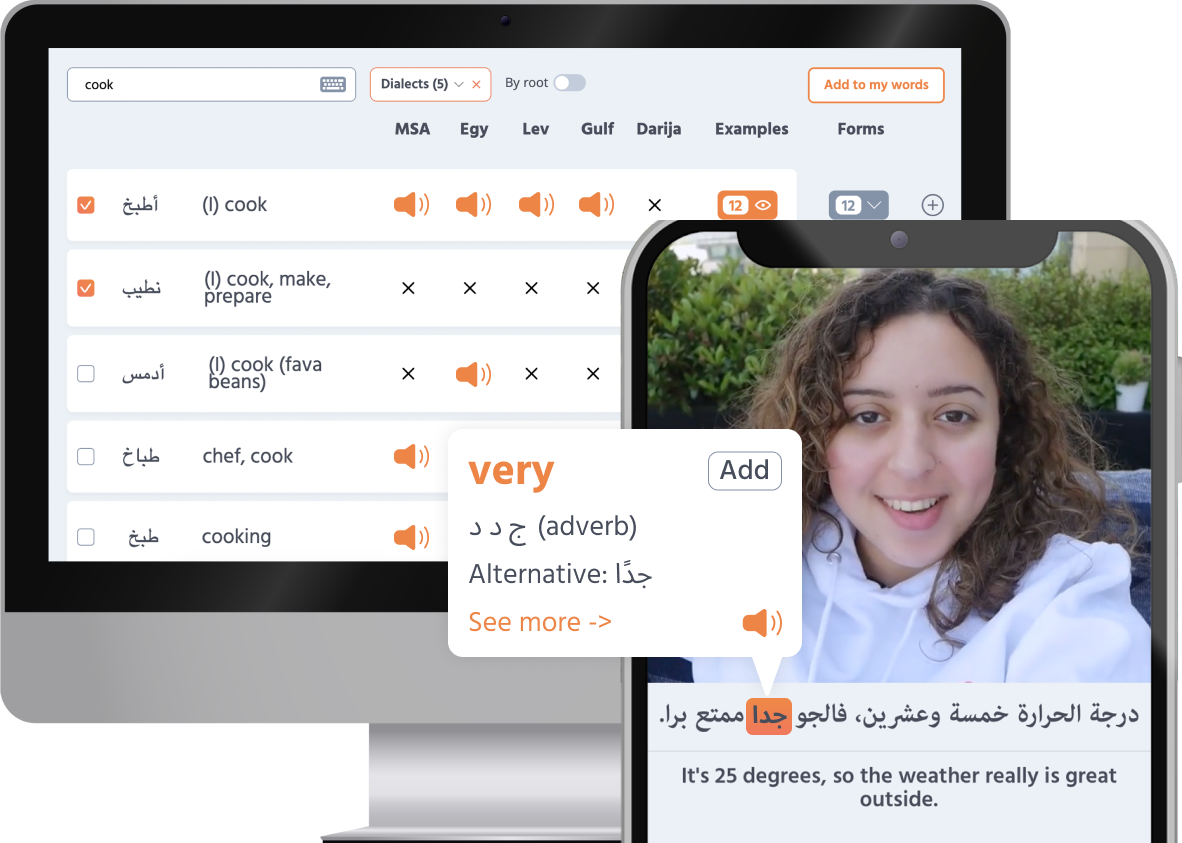When it comes to learning a new language, many English speakers often wonder, “Is Arabic easy to learn for English speakers?” or “Is Arabic hard to learn for English speakers?” If you’ve asked yourself these questions, you’re in the right place! Let’s dive into the fascinating world of Arabic and find out if it’s easy for English speakers to learn Arabic.
The basics of Arabic Arabic is a rich and ancient language, spoken by over 300 million people across more than 20 countries. It’s the liturgical language of Islam, the Quran, and a key to understanding the diverse cultures of the Arab world. Arabic has a standardized version and several dialects , including Egyptian , Levantine , Gulf , and Maghrebi .
Major dialects : Egyptian, Levantine, Gulf, and Maghrebi
Egyptian Arabic : Spoken by over 90 million people, Egyptian Arabic is widely understood due to the popularity of Egyptian cinema and media. It’s a great choice if you’re interested in entertainment and pop culture.Levantine Arabic : Used in Lebanon, Jordan, Palestine, and Syria, Levantine Arabic is known for its melodious tone. It’s perfect if you plan to travel or work in these countries.Gulf Arabic : Spoken in countries like Saudi Arabia, Kuwait, the UAE, and Qatar, Gulf Arabic is a must if you’re heading to the oil-rich Gulf region for business or travel.Maghrebi Arabic : Used in Morocco, Algeria, Tunisia, and Libya, Maghrebi Arabic is heavily influenced by Berber and French. It’s known for its unique sound and vocabulary.
Is Arabic easy to learn for English speakers? The short answer is: it depends! Here are some factors to consider:
Pronunciation and phonetics Comparison of Arabic and English phonetic systems : Arabic has sounds that don’t exist in English, like the guttural ق
and the emphatic ص
. This can be challenging at first.
Common pronunciation challenges for English speakers : These include differentiating between sounds like ع
and غ
, which have no direct equivalents in English.
Below, a kids’ song about the Arabic alphabet highlights the difference in pronunciation between the two letters.
From Adam Wa Mishmish .Factors that make pronunciation easier :
Familiar sounds : Arabic shares some sounds with English, like “m” م
and “b” ب
.Consistent rules : Arabic pronunciation rules are more consistent than English, which has many exceptions.Practice tools : Apps, language exchange, and native speakers can aid in mastering pronunciation.
The alphabet and writing system Learning Arabic script
عبد الله , CC BY-SA 4.0 , via Wikimedia Commons.Techniques for improving reading and writing skills in Arabic :
Practice regularly : Daily writing practice can significantly improve your skills. Start with simple sentences and gradually increase complexity.Use reading materials : Children’s books, news articles, and short stories are great for beginners.Write by hand : Writing Arabic by hand can help you become more familiar with the script and its flow.Use technology : Online learning platforms like Playaling provide interactive practice.
Common pitfalls and how to avoid them :
Letter confusion : Some letters look similar, like ب
(b) and ت
(t). Pay close attention to the dots, which differentiate these letters.Right-to-left writing : Writing from right to left can be confusing initially. Practice slowly and methodically until it feels natural.Vowel marks : Arabic usually omits short vowel marks (diacritics) in writing, which can make reading challenging. Beginners should use texts with these marks to improve reading accuracy.
Grammar and sentence structure Understanding the root system : Arabic words are built from three-letter roots that convey a core meaning. For example, the root ك ت ب
relates to writing. From this root, you get words like كتاب
(book), كَتَبَ
(he wrote), and مكتب
(office). This root system helps in understanding and memorizing vocabulary, as once you know the root, you can recognize and infer the meanings of many words.
Common grammatical hurdles and how to overcome them :
Verb conjugation : Arabic verbs change form based on tense, mood, and the subject. Regular practice and using conjugation charts can help in mastering these patterns.Gender agreement : Nouns and adjectives must agree in gender. Paying attention to gender markers and consistent practice can make this easier.Sentence structure : English uses a Subject-Verb-Object (SVO) order, but Arabic can follow a Verb-Subject-Object (VSO) order or a Subject-Verb-Object (SVO) order. Writing and translating simple sentences can help in getting accustomed to this structure.
Vocabulary Differences in vocabulary and expressions : Arabic has a rich and diverse vocabulary. Expressions and idioms can be quite different from English, adding to the charm and complexity of the language.
Strategies for building an Arabic vocabulary :
Flashcards : Use flashcards to memorize new words and phrases.Thematic learning : Group words by themes, like food, travel, or emotions, to make them easier to remember.Consistent practice : Regularly read, write, and speak in Arabic to reinforce your vocabulary.
The role of cognates and loanwords : Many English words have Arabic origins , especially in science, mathematics, and astronomy (think “algebra,” “alchemy,” and “zenith”). Recognizing these cognates can give you a head start. Additionally, modern Arabic has borrowed words from English, especially in technology and contemporary culture, such as تلفزيون
(television) and موبايل
(mobile phone). Moreover, knowing some Spanish could help you expand your Arabic vocabulary as well.
Cultural immersion Learning a language goes hand-in-hand with understanding its culture. Cultural nuances influence communication styles, body language, and social norms, which are crucial for truly mastering a language.
Examples of cultural nuances in Arabic communication :
Greetings : Arabic greetings often involve elaborate expressions of goodwill and inquiries about one’s health and family.Hospitality : Arab culture places a high value on hospitality . When visiting someone’s home, it’s customary to bring a small gift and accept food and drink offered to you.
Respect and politeness : Showing respect to elders and using polite forms of address are important in Arabic-speaking cultures.
Tips for immersing oneself in Arabic culture :
Travel : If possible, visit an Arabic-speaking country to experience the language and culture firsthand.
Engage with the community : Participate in cultural events, join local Arab communities, and attend cultural festivals.
Listen to Arabic music : Music reinforces language learning through repetition, helping to solidify vocabulary and grammar in a memorable and enjoyable way.
Watch Arab movies and series: You’ll learn many words used in everyday life and understand Arab culture and daily lifestyle.
A mother advises her daughter on how to deal with romantic encounters. From the Syrian series أهل الغرام.
Learn through cuisine: Explore Middle Eastern cuisine by cooking traditional dishes and learning the names of ingredients and recipes in Arabic. Here are some videos about Arab food:
Cultural etiquette : Familiarize yourself with cultural etiquette, such as greetings, dining manners, and social customs.
Don’t miss our blog on the Etiquette of Paying the Bill —and be sure to check out the hilarious parody below! It perfectly captures the often comedic back-and-forth as good manners demand a relentless insistence on paying. Get ready for a surprising twist at the end that you won’t see coming!
A parody of Arab etiquette: Paying the bill .Tips for learning Arabic
Start with MSA and one dialect : Build a solid foundation in MSA and one major dialect, then explore other dialects that interest you.Practice regularly : Consistency is key. Practice speaking, listening, reading, and writing as often as you can.Use online platforms: Learning with real world videos can make your learning experience both enjoyable and effective. Playaling provides interactive videos, audio clips, and quizzes tailored to different proficiency levels, offering an immersive approach that keeps you engaged and motivated. Sign up now for a free trial and discover a new, exciting way to master a language!Join language exchange groups : Practice with native speakers through language exchange programs or online platforms.Immerse yourself : Watch Arabic videos, listen to Arabic music, and try to engage with Arabic speakers in your community.Be patient and persistent : Learning a new language takes time. Celebrate small victories and keep pushing forward.
Oh, and by the way… If learning Arabic at your own pace, with fun, real-world videos sounds like your style, then Playaling could be exactly what you’re looking for!
With Playaling, you’ll dive into any major Arabic dialect or MSA. Our diverse range of videos has it all—from everyday conversations and cultural moments to music videos, TV and movie clips, influencer content, news broadcasts, and inspiring talks.
Our interactive captions let you tap any word for instant translations, context, and audio. So, real Arabic content becomes accessible with just a click. Miss something? No problem—rewind and listen as often as you need, or hover over subtitles for quick definitions.
Spot a word you want to learn? Save it to your personalized word set, or dive into curated sets for focused practice and easy review.
Interactive exercises let you dive in and practice what you’ve learned.
Need to look something up? The Audio Dictionary has you covered with clear human pronunciations and real world examples.
It’s a learning experience that keeps you engaged, bringing authentic, real-world Arabic closer to you every step of the way.
Give it a try!









